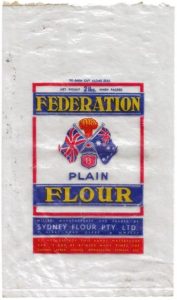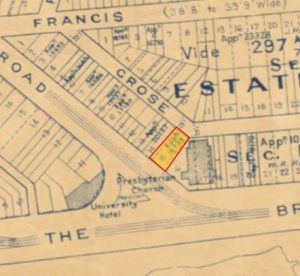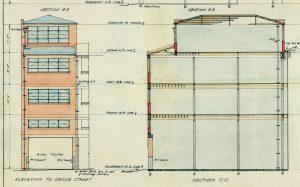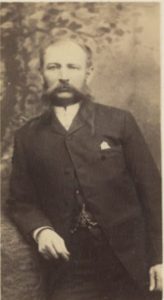Rodney Hammett, Bulletin 1/2022, March 2022

A month or so ago Beth Sergeant gave Ted McKeown an old plastic bag that originally contained 2 lbs (0.9 kg) of plain flour under the name of Federation Flour. Interestingly, written on the bag is ‘Do not destroy this handy waterproof bag. It can be used many times for lunches, bread, picnics, refrigerator storage etc’. See Figure 1.
Certainly, this is an early example of recycling and care for the environment. So far, however, a date of the bag has not been established but it was before 1974 when metrics were introduced in Australia.
Federation Flour was packaged and sold by Sydney Flour Pty Ltd, of 1 Glebe Rd, Glebe, now the site of 279 Broadway. The site had been purchased by Adolph Frederick Brockhoff, and his sons Frederick Douglas Brockhoff (1868-1961) and Charles Thomas (1874-1948) in January 1906, next to the Presbyterian Church at the corner of Glebe Point Rd and Broadway.1 See Figure 2 for the site in 1910. The building which the business occupied at 1 Glebe Rd still exists today however the firm ceased business here in 1966.
Later, after the church had been moved stone by stone to its current location in Bridge Rd in about 1927, the church site (263 Broadway) was also purchased by the firm, on which it constructed a flour mill. Plans for a 1941 alteration to this building were found at the City of Sydney Archives.2 See Figure 3.

The son of a tanner, AF Brockhoff was born in Germany in 1841. After fighting in the Union Army in the American Civil War, in 1863 he departed Liverpool, England on the ship Maryborough for Melbourne where he arrived on 11 December.3 Although only 22, he first opened a general store at Port Fairy on Victoria’s southern coast before changing to making biscuits in Melbourne. In 1867 Adolph married Scottish born Jessie Scott Douglas, in her parents’ Melbourne family home.
A family ensued – Frederick (1868 at Port Fairy), Linda (1869), Clara (1870), Thomas (1874), Mabel (1877) and Stella (1884), before in August 1894 his wife, Jessie, died at the age of 47 ‘after a long and painful illness’.4
Adolph Brockhoff for some time worked with other biscuit makers in partnership, all based in Melbourne. There was Stewart and Brockhoff in the 1870s then Kimpton and Brockhoff in the early 1880s; however, his partners did not survive various liquidity problems. In 1882, AF Brockhoff & Co was established and remained family owned for over 80 years. Initially located in West Melbourne, the flour mill and biscuit factory moved to a larger site at Burwood, Victoria, in the 1930s.
Brockhoff Biscuits had many popular favourites such as Chocolate Royals, Chocolate Ripple, Salada and Shapes. They even had their own jingle5:
Clap hands, here comes the Brockhoff baker,
Clap hands here comes the biscuit man,
With his oven-crisp biscuits, tasty and nice,
So rich with butter, sugar and spice,
Clap hands for the Brockhoff biscuit man.

Adolph withdrew from managing the business in 1890 to give Frederick the reins. The firm’s expansion into NSW occurred in 1893 with the opening of an office at 255½ Sussex St in the CBD, describing itself as self-raising flour merchants. Charles relocated to Sydney in about 1899 initially living with his new wife at Joubert St, Hunters Hill.6 The firm also expanded into Western Australia with an office in Perth.
Now able to have leisure time, Adolph travelled extensively, including to Japan and Europe. In Chelsea, England, on 1 January 1896, aged 54, he married 18-year-old Rosa Edith Goodwin. The new couple came to live in his St Kilda, Melbourne home which must have been difficult for his eldest and single daughter Clara, then in her late 20s, who was also residing there. At some stage Rosa returned to England where she died in 1910 at the age of 33, with Adolph at her side. He returned to Sydney on the ship Barbarossa which departed Southampton on 26 December 1910.
Not quite 12 months later Adolph married 33-year-old Mabel Evelyn Chandler in Sydney in November 1911. She too died early at the age of 44 in 1922 when he was 81. He died the following year and is buried in the St Kilda Cemetery along with wife, Jessie, and daughters, Clara and Mabel. His estate for probate was valued at £65,242 7s 5d, of which £36,000 was the value of his shares in AF Brockhoff & Co.

Charles certainly had a senior role in the NSW part of the AF Brockhoff business; however, in 1913 for some reason the three-way partnership of Adolph, Frederick and Charles was changed to only Adolph and Frederick.7 In September 1918, aged 44, Charles enlisted for WWI giving 1 Glebe Rd as his address. With the Armistice on 11 November the same year he was not required.
By 1902 Charles, with New Zealand-born wife Lucy Annie (nee Penlington), had moved to live at Mowbray Rd, Chatswood, where they raised Thomas Adolph (1898-1964) and Douglas Charles (1900-1974). Charles was a keen sailor and became a member of the Royal Sydney Yacht Squadron with his yacht, Scotia. In the 1920s the newspapers often reported on its successes on Sydney Harbor sailed by son Douglas. Later the family moved to Manly, where Charles died in September 1948.
Frederick was undeniably a strong and competent business manager and his three sons also proved to be the same. In 1930 he relinquished control of the business to Alan, Harold and Jack and it was the youngest son Jack (later Sir Jack) who became the managing director. It was he who led the company into a merger with previous competitors Arnotts and Guests, forming the Australian Biscuit Company in 1964 to thwart the ambitions of American-owned Nabisco. (Further reading at https://australianfoodtimeline.com.au/savoury-shapes/ and for Sir Jack Brockhoff at https://adb.anu.edu.au/biography/brockhoff-sir-jack-stuart-12256)
In Glebe, the flour mill was eventually demolished (date not yet identified) and on the site (No 263 Broadway) is now an unappealing building at the gateway to Glebe. The City of Sydney in 2016 reviewed the planning controls for 225-277 Broadway, and subsequently in July 2018, NSW Planning and Environment approved an amendment to LEP 2012 for this part of Broadway as a Gateway development.
Notes: 1. NSW Land Registry Services; Bk 796 No 429; 2. https://archives.cityofsydney.nsw.gov.au/nodes/view/60703; sourced by Ted McKeown; 3 Ancestry.com; shipping records; 4. Trove; Argus; Mon 13 Aug 1894, p. 1; 5. The full jingle can be listened to on YouTube: https://www.youtube.com/watch?v=BeUrnGIDkvU; 6. Sands Directory – Alphabetical Listings; 7. Trove; NSW Government Gazette; Wed 3 Dec 1913, p. 7295.









4 comments. Please add yours.
Thank you for your offer. Please send it to us at PO BOX 100 GLEBE NSW 2037 and we will keep it in our collection.
Regards
Rodney Hammett
I have a 6lbs plastic bag as show above and, as stated on the bag, we have not destroyed it but have reused it many times
and has been in the family for many years
Please advise if you would like it for your historical collection
We’re delighted you enjoyed the article. Thanks for pointing out Charles had a daughter – Muriel Lucy. She will be added to our records. You might be interested to read a follow-up article on all the flour mills in Glebe in the May 2022 Bulletin. See https://glebesociety.org.au/socialhistory/flour-mills-in-glebe-point-rd/
Regards
Rodney Hammett
This article is great! Thanks for putting it together as it is the most comprehensive account of the Brockhoff family….Charles Thomas was our great grandfather! He also had a daughter, Muriel Lucy thanks….Sue, Jill and Debra